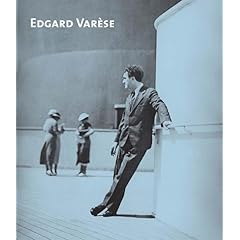What, Edgard Varese as sideman?
 Paul Griffiths gets off one zinger of a closing paragraph in the October 6 2006 issue of the Times Literary Supplement (London). The book under review is: Felix Meyer and Heidy Zimmermann (editors), Edgard Varese: Composer, sound sculptor, visionary (500 pp., Boydell and Brewer, 25 pounds sterling).
Paul Griffiths gets off one zinger of a closing paragraph in the October 6 2006 issue of the Times Literary Supplement (London). The book under review is: Felix Meyer and Heidy Zimmermann (editors), Edgard Varese: Composer, sound sculptor, visionary (500 pp., Boydell and Brewer, 25 pounds sterling).
” … Unlikely as it must seem to anyone familiar with the old myth of the lonely pioneer,” Griffiths writes, “Varese did indeed work with jazz artists, including the trumpeter Art Farmer, the saxophonist Teo Macero and the drummer Ed Shaughnessy. We have the evidence, as [Olivia] Mattis tells us in perhaps the most tantalizing sentence of the book: ‘Recordings of several of these sessions, which also survive in the Paul Sacher Foundation archives, are astonishing.’ Perhaps, before scholars descend to wear these tapes out, the Sacher Foundation could release them on CD. Varese swinging: that would be something to hear.”
Note the “also” in the passage above. Question: So who else has these tapes?
PS. See amplification by Steve Layton and Micah Silver below in “Comments.”
I’ve known about these sessions for a while, because my understanding is that Earle Brown attended and had a hand in setting these sessions up.. may have happened at Capitol Records studios where he was working. ..Also the “charts” as I have heard, are more about experimenting with notation and conduction. .. not Varese trying his hand at a solid 32 bars or swinging along on the vibes…. anyway i think Macero has the tapes.. but Olivia knows everything..
Richard Buell to Steve Layton (10/12/06):
\” … Am I alone in this, or didn\’t Paul Griffiths express himself rather ambiguously? At the back of my mind I was wondering exactly what Varese would have been playing but I let that pass. And \”swinging\” (Griffiths\’ word) would ordinarily suggest performance, I think, rather than a chart.\”
Steve Layton to Richard Buell (10/12/06, e-mail quoted by permission):
\” … In fairness, the book isn\’t *absolutely* clear on the matter. It seems that Varese just contributed the \”chart,\” but who knows? Maybe he\’s in there banging one of his gongs or something. We won\’t know until the recordings are made available, and maybe not then …
\”I picked the book up right away when I read a blurb about it on Kyle Gann\’s blog (he contributed one of the chapters, so probably got a copy as soon as it was published). You know, it\’s actually the catalog of an exhibition held this past summer at the Sacher Foundation in Switzerland. To see it all in person would have been a real trip!
\”Louise Varese wrote her husband\’s bio, and it\’s actually pretty tough/fair considering, and well worth finding a copy. But she only got volume one completed. and that only went to about 1928 or 29. What\’s great in this book are the number of references taken from the surviving draft of the unpublished volume two; getting a better idea of what Varese was up to (and not up to) for the 25-odd-years until \’Deserts.\’\”
\” … I\’d love to know more myself! This stuff seems to have just had its very first good look-through and sorting. Now if somebody will turn a few grad students loose on it, dissertations await …\”
— RB
I don’t think the “also” means there are known multiple copies of these recordings; I have the book & looking at the passage in question, it seems to refer to having the recordings “in addition to other related material”. And it doesn’t seem that Varese was a player, but rather wrote the “chart” for a series of improvisations.
The whole thing’s tied up with the creation of the Poeme Electronique around 1957. Varese wrote a kind of graphic score or “sketch” before ever going off to Europe to have the engineers at Phillips Lab realize it. You can see part of it HERE.
Interestingly enough, it seems to be practically identical with the “chart” that varese brought to these sessions to have the jazz guys improv from! (there are images of both in the book).
Besides the jazz guys, some of the sessions included John Cage and Merce Cunningham (and Teo Marcero says that Charlie Mingus was there, too). Also sitting in was Earle Brown, who was working at Capitol Records and seems to have put the whole thing together. It only lasted from March through August, when Varese took off for Europe.
It’s a wonderful book, full of fascinating and surprising documents and information. Now that Varese’s archive has a home, someone can someday finally start on a real, full and rounded biography; until then, this book will at least fill in some of the holes.